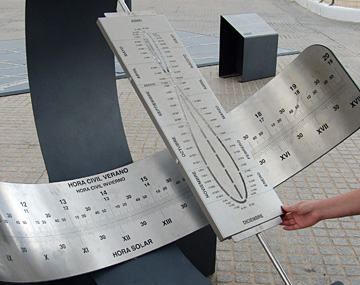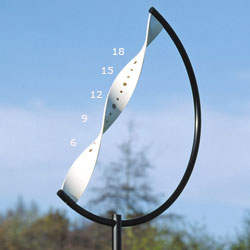MAKING SUNDIALS
Some peculiarities should be taken into consideration, when making sundials. First, you need to know geo-position of the place, where you plan to use your sundials. Both stationary and portable sundials should be installed in accordance with our place on the Earth.
Latitude

First and most important geographical coordinate is latitude.
It is marked as φ on the draft; latitude equals to angle of polar gnomon Gp.
Vertical (Gv) and horizontal (Gh) gnomons will draw different geometry of
hour lines at different latitudes too.
In fact latitude expresses angular distance of your local place from equator. It is 0° on equator,
+90° at the north pole, and -90° at the south pole. Thus, the angle of polar gnomon will
vary from 0° (horizontal position) at equator to 90° (vertical position) at poles.
Diurnal pecularities of Sun's movement depend on latitude dramatically: from midnight sun within arctic zones to
monotonous sunrise at 6 and sunset at 18 on equator.
Daily maximum of Sun's height at noon varies respectively. For instance, at Moscow parallel it varies from
11° at winter solstice to 57° at summer solstice.
Within north and south tropic's parallels one can see the Sun just above his head, with no shadow at all.
Please, take into account, that you needn't to know geographical longitude to
make sundials, telling true time.
Time indication

There is a common view on sundials as a primitive timekeeping device, which was used in ancient times, but now it's only a historical artifact with fleur of sophistication. It is not true. Sundials are measuring Sun's height and/or azimuth. All of them did and do. Sundial's precision is a matter of accurate marking, making and mounting. Perfect sundials can not lie, or accumulate any time errors. The only thing really important for sundials is light from the Sun. Different hours marking may be done for one gnomon, or multiple gnomons may be used for one dial. Dials may be marked for different timing systems as follows:
- true time - Sun local time;
- mean zone time - our usual civil time which varies from true time within ±15 minutes; additional DST correction may be needed; in respect to civil time it does make sense to talk about sundial's precision, because of accuracy of our calendar and leap year problem; for correct time indication we need to know another geographical coordinate - longitude.
- Italian hours - time in hours since last sunrise;
- Babylon hours - time in hours since last sunset;
- unequal hours - ancient timing system with hours of different duration throughout the year;
- certain day of the year - yearly calendar based on Sun's declination;
Chosen timing lines are the base of dial's design.
Just one story from personal experience of designing sundials for Moscow planetarium. The customer neglected
our reasoning that sundials in such place should tell local sun time.
Counter argument was: during strictly scheduled excursion the pupils will be confused by not compliance with ordinary civil time, and "will be asking too
many questions".
The final choice was for local sun time (with longitude and DST correction) for
usage only in summer time, and another contractor.
The moral is that you may use any time marking you want. But think about
the meaning of the indications.
Traditionally, sundials tell the time in correspondence with their motto. This tradition
is respect to sacral roots of sundials, and should be cared about.
Say, "Little knowledge is a dangerous thing" may be a good motto in some cases.
Gnomon and its shadow

The pointer, whose shadow forms sundial's "hand", is called gnomon. Accuracy of its mounting defines the accuracy of readings. When designing sundial we must think about shadow's readability on the surface of dial, as well as diffraction of Sun's light. The last means that shadow's readability depends on the distance between gnomon and dial's surface. Shadow's border is getting blurry at long distances.
The design of gnomon and dial are closely related. Just one photo of brilliant sundials designed by architect Piet Hein for illustration. Try to distinguish gnomon from dial .
In section PRACTICE we plan to put articles with our experience and ideas worth sharing. Together with links to programs, needed to calculate sundials, it is enough to start making your own sundials. Good luck and more sunny days!
Contacts
We welcome any contacts with architects and designers, creating their constructions with respect to Sun's lighting.
mail@analemma.ru
007 903 720-24-XII

